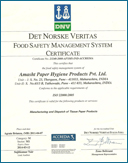|
 |
|
Amasht Hygiene E-news | September 2011 |
|
|
|
|
| A well managed restaurant pest control program comprises of three basic steps: |
|
|
| Inspection: This leads to an idea of the presence of pests and where they are harboring, traveling, so that pesticide applications can be decided. |
| • |
Inspect possible harborages or hiding spots for live pests, feces, cast skins and egg cases. Rodents, roaches and flies usually leave behind some evidence of active infestations. |
| • |
Inspect trash bins, sinks, floor drains, kitchen equipment, wall voids, electrical outlets, electrical boxes,
any hollow tubing on appliance legs and any other crack, crevice or void where a rodent or insect may have taken up residence. |
| • |
Place glue boards near suspected infestations. This will help monitor suspected problem areas, and understand what type of pest you have and where to apply treatments. |
|
|
|
|
|
|
|
|
|
| Proper Sanitation is one of the key elements in pest control. Trash bins, sinks, floors and kitchen equipment should be cleaned as often as possible, and especially before leaving overnight. Any one of these areas could potentially lead to a pest infestation if left unchecked. |
| |
|
Exclusion means keeping the pests out before they become a problem. Make sure there are tight weather seals around doors and windows; caulk any openings leading to wall voids and never leave doors or unscreened windows open. Treating for pests outside may also stop them from invading indoors. The three pests that seem to be a problem in almost every food service company are roaches, flies and rodents. |
| When the three steps above are followed consistently over time, in conjunction with proper pesticide application, pest problems can be reduced and controlled. |
|
 |
 |
 |
| |
Tissues are better than cloth handkerchiefs as the latter accumulate germs on them, leading to infections. Therefore, carrying tissues is a better idea, as they are disposable.
Carry tissues and use them to catch coughs and sneezes.
We have between 2 and 10 million bacteria between fingertip and elbow. |
|
|
|
|
If you don't want to receive this newsletter, please click on ′unsubscribe′
Amasht Paper Hygiene Products Pvt. Ltd., S.No.23, Thergaon, Pune 411033. email: amasht@vsnl.com www.amasht.com
Please click here if you can′t view the newsletter properly. |
|
|
|
|
|
|